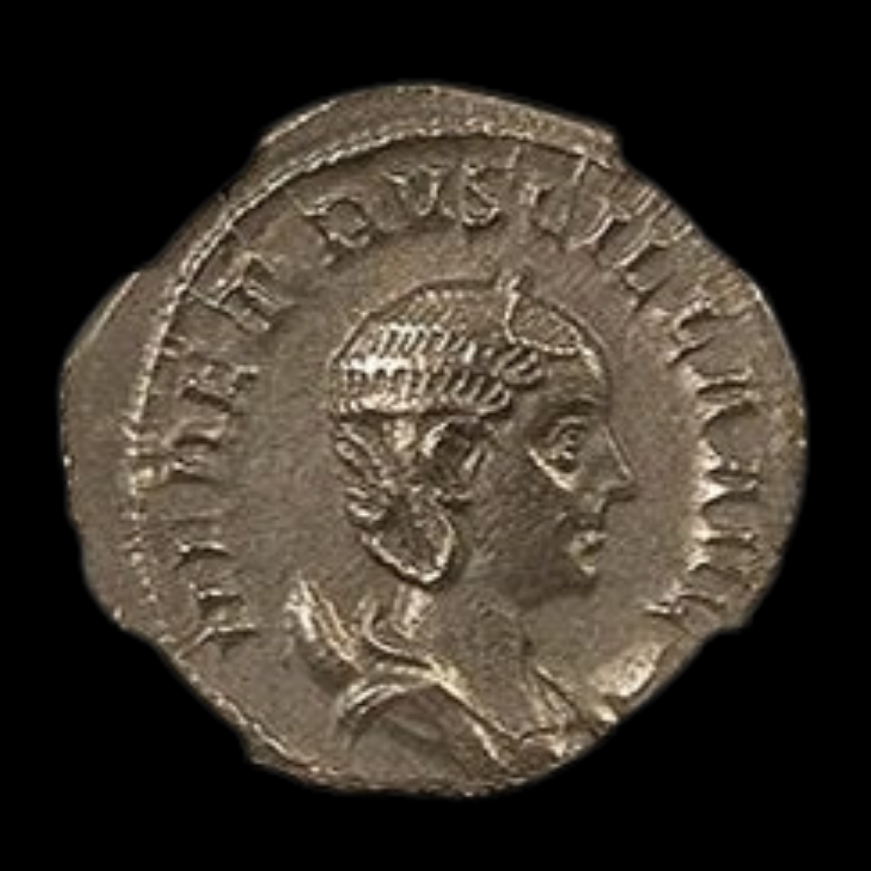 Image 1 of 6
Image 1 of 6

 Image 2 of 6
Image 2 of 6

 Image 3 of 6
Image 3 of 6

 Image 4 of 6
Image 4 of 6

 Image 5 of 6
Image 5 of 6

 Image 6 of 6
Image 6 of 6







Roman Silver Coin of Empress Herennia Etruscilla (about 1,770-1,775 years ago)
The coins shown are representative examples of the grade and type, but not the actual specimens for sale. For details on NGC’s grading standards and definitions, please refer to our NGC Grading page.
This silver denarius depicts Herennia Etruscilla, wife of Emperor Trajan Decius and a woman who briefly wielded significant power as regent during the chaotic mid-third century. Though little biographical information about her survives, her coins provide tangible evidence of her official recognition as Augusta (empress) and her brief but notable role in imperial governance during one of Rome's most volatile periods.
Coin Description:
Front side: Portrait of Empress Herennia Etruscilla facing right, typically shown with hair parted in the middle and gathered in a bun at the nape of her neck, with Latin inscription giving her name and titles
Back side: Likely depicts Pudicitia (Modesty), Juno, or another female deity or personification reflecting traditional Roman feminine virtues, with accompanying Latin text
Technical Details:
Silver composition (though with declining silver content typical of this period)
Denomination: Denarius
NGC certified
Minted between 249-251 AD
Condition as certified by NGC
Historical Significance:
Herennia Etruscilla emerges from the limited historical record as an empress who briefly exercised real political authority during a crucial transition in the Crisis of the Third Century. Probably from an aristocratic senatorial family, she gained prominence when her husband Trajan Decius seized power in 249 AD. Her greatest significance came in 251 AD, when her husband and elder son Herennius Etruscus were killed fighting Gothic invaders at the Battle of Abritus (in modern Bulgaria). In the aftermath of this disaster, Herennia briefly served as regent for her younger son Hostilian, who was too young to rule independently. This regency was short-lived, as Hostilian soon died of plague and was succeeded by Trebonianus Gallus. Herennia's subsequent fate remains unknown, making her coins particularly valuable as rare tangible evidence of a woman who briefly wielded significant influence during one of Rome's most turbulent periods.
The coins shown are representative examples of the grade and type, but not the actual specimens for sale. For details on NGC’s grading standards and definitions, please refer to our NGC Grading page.
This silver denarius depicts Herennia Etruscilla, wife of Emperor Trajan Decius and a woman who briefly wielded significant power as regent during the chaotic mid-third century. Though little biographical information about her survives, her coins provide tangible evidence of her official recognition as Augusta (empress) and her brief but notable role in imperial governance during one of Rome's most volatile periods.
Coin Description:
Front side: Portrait of Empress Herennia Etruscilla facing right, typically shown with hair parted in the middle and gathered in a bun at the nape of her neck, with Latin inscription giving her name and titles
Back side: Likely depicts Pudicitia (Modesty), Juno, or another female deity or personification reflecting traditional Roman feminine virtues, with accompanying Latin text
Technical Details:
Silver composition (though with declining silver content typical of this period)
Denomination: Denarius
NGC certified
Minted between 249-251 AD
Condition as certified by NGC
Historical Significance:
Herennia Etruscilla emerges from the limited historical record as an empress who briefly exercised real political authority during a crucial transition in the Crisis of the Third Century. Probably from an aristocratic senatorial family, she gained prominence when her husband Trajan Decius seized power in 249 AD. Her greatest significance came in 251 AD, when her husband and elder son Herennius Etruscus were killed fighting Gothic invaders at the Battle of Abritus (in modern Bulgaria). In the aftermath of this disaster, Herennia briefly served as regent for her younger son Hostilian, who was too young to rule independently. This regency was short-lived, as Hostilian soon died of plague and was succeeded by Trebonianus Gallus. Herennia's subsequent fate remains unknown, making her coins particularly valuable as rare tangible evidence of a woman who briefly wielded significant influence during one of Rome's most turbulent periods.



























